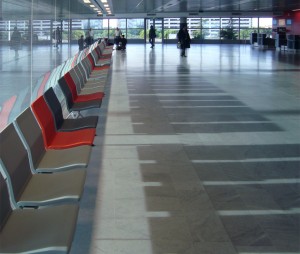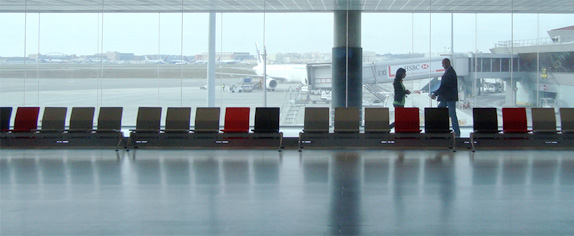Airport design | Designer | Producer | Product | smow offline | USM Haller | Vitra

Despite the many disadvantages, problems and general chaos budget airlines have brought into our previously well structured and ordered lives, they have brought one clear advantage: The opportunity to visit really remote airports.
More through necessity than freewill, thousands of air travellers now find themselves avoiding the likes of Heathrow, Charles de Gaulle or Frankfurt am Main Airport, and instead experiencing the delights of Klagenfurt, Tampere or Altenburg.
At least in all modern airports the quality of the airline design and for all the airport furniture is guaranteed.
At Leipzig Altenburg, for example, those passengers wanting a last cigarette before boarding their flight can enjoy it in the comfort of an original Herman Miller fibre glass Eames Armchair. Or while reporting your luggage as having been left in Milan is never an enjoyable experience; at Leipzig Halle Airport you can at least admire the aesthetic and practical beauty of the System USM Haller elements while you wait. And then again at the hire car desks; where the USM Haller elements are cleverly colour matched to the corporate design of the car hire companies.

One of the real winners in the era of budget airlines however has been Toulouse Blagnac Airport. Construction of the airport started in 1939; while on the one hand not the best year to start a major construction project in Europe, it did at least provide the occupying Germans with a base for the production of V1 and V2 rockets as well as a dive-bombing school.
Following the liberation of France civil operations began again at Toulouse Blagnac. In 1953 27,000 passengers passed through the airport. By 1990 this had risen to 3 million passengers a number which then exploded to 5 million in 1999 and six million passengers a year in 2007.
A fact no doubt helped by the fact that the airport is much beloved by budget airlines.
This growth in passengers has of course necessitated a need for ever new buildings, and Toulouse Blagnac Airport is currently in the middle of a large expansion programme. An important cornerstone of this expansion is the new Hall D, a facility which will allow the airport to process some 8,5 million passengers a year.

A, dare we say, typical and somewhat passe all glass facade means that passengers at Toulouse Blagnac Airport could have the feeling of being at any airport in Europe; could - were it not for the wonderful utilisation of Sir Norman Fosters Airline seating system from Vitra.
Created in 1998, the Airline system is used in many airports throughout Europe, but always in black.
In Toulouse however the architects have opted for a range of colours; the resulting 1970s bus station effect is both more playful and relaxing than the norm.
In addition the Foster Airline seating has been wonderfully complemented with a range of .04s by Maarten van Severen on traverses, again from Vitra.
For those of you wanting to wanting to experience the Toulouse Blagnac Airport design yourselves; fights to Toulouse can be found starting form all minor European airports. And Heathrow, Charles de Gaulle or Frankfurt am Main.
And for those of you looking for Vitra, USM Haller or indeed any designer furniture for your airport, hospital, hotel or bus station the (smow) contracts team can offer professional and competent advice.
